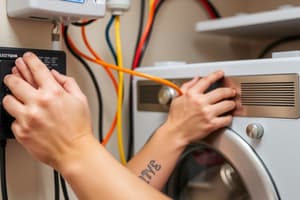Podcast
Questions and Answers
What is the charge of a proton and how does it relate to an electron's charge?
What is the charge of a proton and how does it relate to an electron's charge?
- Protons have a positive charge that balances the negative charge of electrons. (correct)
- Protons have a negative charge that cancels the positive charge of electrons.
- Protons possess a negative charge while electrons are positive.
- Protons are neutral and do not interact with electrons.
How many protons and electrons does a hydrogen atom contain?
How many protons and electrons does a hydrogen atom contain?
- One proton and one electron. (correct)
- One proton and one neutron.
- Two protons and one electron.
- Two protons and two electrons.
What determines the stability or neutrality of an atom?
What determines the stability or neutrality of an atom?
- Having more electrons than protons.
- Having an equal number of neutrons and protons.
- Having an equal number of electrons and protons. (correct)
- Having an unequal number of protons and neutrons.
What is the maximum number of electron shells that an atom can have?
What is the maximum number of electron shells that an atom can have?
Which statement accurately describes the behavior of electrons in an atom?
Which statement accurately describes the behavior of electrons in an atom?
What is the primary source of electrical energy in atoms?
What is the primary source of electrical energy in atoms?
What does Ohm's Law primarily describe?
What does Ohm's Law primarily describe?
According to the First Law of Thermodynamics, what can be said about energy?
According to the First Law of Thermodynamics, what can be said about energy?
Which of the following best describes electrical energy?
Which of the following best describes electrical energy?
What is the role of a voltmeter?
What is the role of a voltmeter?
What do watt meters and kilowatt-hour meters measure?
What do watt meters and kilowatt-hour meters measure?
What potential risks are associated with electricity?
What potential risks are associated with electricity?
How are orbiting electrons related to protons in a neutral atom?
How are orbiting electrons related to protons in a neutral atom?
Flashcards are hidden until you start studying
Study Notes
Understanding Electricity and Electrical Energy
- People often take electricity for granted, relying on it daily while simultaneously fearing potential dangers like burns and shocks.
- A thorough knowledge of electricity can mitigate fear, but respect for its power is crucial due to serious injury risks.
- A significant percentage of heating and cooling service calls are related to electrical issues, emphasizing the need for understanding electrical systems.
Fundamentals of Electrical Energy
- Electricity is defined as energy derived from the movement of electrons between atoms.
- Key concepts include:
- Electromotive Force: The driving force that moves electrons.
- Voltmeters: Tools used to measure electrical potential.
- Ammeters: Devices that measure current flow.
- Ohm’s Law: Describes the relationship between voltage, current, and resistance.
- Ohmmeters: Tools for measuring resistance.
Energy Conversion Principles
- Electricity is one of several forms of energy, which also includes:
- Heat
- Light
- Chemical
- Atomic
- Mechanical
- First Law of Thermodynamics: Energy cannot be created or destroyed, only transformed from one form to another (e.g., heat into electricity).
Structure of Atoms
- All matter consists of atoms, the fundamental units of chemical elements.
- Key components of an atom:
- Nucleus: Contains protons (positively charged) and neutrons (neutral charge).
- Electrons: Negatively charged particles that orbit the nucleus.
- The number of protons defines an element's atomic number (e.g., oxygen has 8 protons).
Atomic Stability and Electron Configuration
- A stable atom has an equal number of protons and electrons, resulting in no net charge (neutral).
- Atoms can have varying electron counts, contributing to element diversity (e.g., copper with 29 electrons, uranium with 92).
- Electrons orbit the nucleus in defined pathways called shells, with those closer to the nucleus being more tightly bound.
Studying That Suits You
Use AI to generate personalized quizzes and flashcards to suit your learning preferences.




